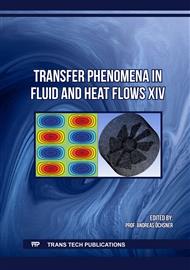[1]
S. Shevtsov, I. Zhilyaev, S.-H. Chang, J.-K. Wu, N. Snezhina, J.-P. Huang, Two-stage numerical approach for reliable recognition of dry spots at the VAP infusion of large composite parts of complex shape, Compos. Struct. 259 (2021) 113437.
DOI: 10.1016/j.compstruct.2020.113437
Google Scholar
[2]
S. Oosterom, T. Allen, M. Battley, S. Bickerton, An objective comparison of common vacuum assisted resin infusion processes, Compos. Part A. 125 (2019) 105528.
DOI: 10.1016/j.compositesa.2019.105528
Google Scholar
[3]
D. Bertling, R. Kaps, E. Mulugeta, Analysis of dry-spot behavior in the pressure field of a liquid composite molding process, CEAS Aeronaut J. (2016) 577–85.
DOI: 10.1007/s13272-016-0207-2
Google Scholar
[4]
W. Hu, T. Centea, S. Nutt, Effects of material and process parameters on void evolution in unidirectional prepreg during vacuum bag-only cure, J. Compos. Mater. 54 (5) (2020) 633–645.
DOI: 10.1177/0021998319864420
Google Scholar
[5]
G.M.C. Magalhães, C. Fragassa, R. de L. Lemos, L.A. Isoldi, S.C. Amico, L.A.O. Rocha, J.A. Souza, E.D. dos Santos, Numerical Analysis of the Influence of Empty Channels Design on Performance of Resin Flow in a Porous Plate, Appl. Sci. 10 (2020) 4054.
DOI: 10.3390/app10114054
Google Scholar
[6]
A. Bejan, Shape and Structure, from Engineering to Nature, Cambridge University Press, New York, 2000.
Google Scholar
[7]
A. Bejan, S. Lorente, Design with Constructal Theory, John Wiley & Sons, Hoboken, N.J, USA, 2008.
Google Scholar
[8]
C. Biserni, L.A.O. Rocha, A. Bejan, Inverted fins: geometric optimization of the intrusion into a conducting wall, Int. J. Heat Mass Transf. 47 (2004) 2577–2586.
DOI: 10.1016/j.ijheatmasstransfer.2003.12.018
Google Scholar
[9]
C. Biserni, L.A.O. Rocha, G. Stanescu, E. Lorenzini, Constructal H-shaped cavities according to Bejan's theory, Int. J. Heat Mass Transf. 50 (2007) 2132–2138.
DOI: 10.1016/j.ijheatmasstransfer.2006.11.006
Google Scholar
[10]
Z. Xie, L. Chen, F. Sun, Geometry optimization of T-shaped cavities according to constructal theory, Math. Comput. Model. 52 (2010) 1538–1546.
DOI: 10.1016/j.mcm.2010.06.017
Google Scholar
[11]
G. Lorenzini, C. Biserni, F.B. Link, L.A. Isoldi, E.D. dos Santos, L.A.O. Rocha, Constructal design of T-shaped cavity for several convective fluxes imposed at the cavity surfaces, J. Eng. Thermophys. 22 (2013) 309 - 321.
DOI: 10.1134/s1810232813040048
Google Scholar
[12]
C.S. Horbach, E.D. dos Santos, L.A. Isoldi, L.A.O. Rocha, Constructal design of Y-shaped conductive pathways for cooling a heat-generating body, Defect Diffus. Forum 348 (2014) 245-260.
DOI: 10.4028/www.scientific.net/ddf.348.245
Google Scholar
[13]
G.V. Gonzales, C. Biserni, E.S.D. Estrada, G.M. Platt, L.A. Isoldi, L.A.O. Rocha, A.J. Silva Neto, E.D. dos Santos, Investigation on the association of differential evolution and constructal design for geometric optimization of double Y-shaped cooling cavities inserted into walls with heat generation, Appl. Sci. 13 (2023) 1998-30.
DOI: 10.3390/app13031998
Google Scholar
[14]
J.C. Martins, M.M. Goulart, E.D. dos Santos, L.A. Isoldi, M.N. Gomes, L.A.O. Rocha, Constructal design of a two ramps overtopping wave energy converter integrated into a breakwater: effect of the vertical distance between the ramps over its performance, Defect Diffus. Forum, 420 (2022) 242-258.
DOI: 10.4028/p-408n90
Google Scholar
[15]
A.N. Impiombato, F. Zinani, L.A.O. Rocha, C. Biserni, Constructal design of an idealized arterial bypass graft: effect of the bypass attachment pointon resistance to flow, J. Appl. Comput. Mech. 7 (2021) 334-344.
DOI: 10.1007/s40430-021-03048-8
Google Scholar
[16]
F.B. Teixeira, G. Lorenzini, M.R. Errera, L.A.O. Rocha, L.A. Isoldi, E.D. dos Santos, Constructal Design of triangular arrangements of square bluff bodies under forced convective turbulent flows, Int. J. Heat Mass Transf. 126 (2018) 521-535.
DOI: 10.1016/j.ijheatmasstransfer.2018.04.134
Google Scholar
[17]
J.P.S. Lima, M.L. Cunha, E.D. dos Santos, L.A.O. Rocha, M.V. Real, L.A. Isoldi, Constructal design for the ultimate buckling stress improvement of stiffened plates submitted to uniaxial compressive load, Eng. Struct. 203 (2020) 109883.
DOI: 10.1016/j.engstruct.2019.109883
Google Scholar
[18]
D.M.P. Kucharski, V.T. Pinto, L.A.O. Rocha, E.D. dos Santos, C. Fragassa, L.A. Isoldi, Geometric analysis by constructal design of stiffened steel plates under bending with transverse I-shaped or T-shaped Stiffeners, FU Mech Eng. 20 (2022) 617 - 632.
DOI: 10.22190/fume211016070k
Google Scholar
[19]
J.C.B. Vianna, E. da S.D. Estrada, L.A. Isoldi, E.D. dos Santos, J.A. Souza, A new Constructal Theory based algorithm applied to thermal problems, Int. J. Therm. Sci. 126 (2018) 118–124.
DOI: 10.1016/j.ijthermalsci.2017.12.023
Google Scholar
[20]
V.A. Pedroti, C.C. De Escobar, E.D. Dos Santos, J.A. Souza, Thermal analysis of tubular arrangements submitted to external flow using constructal theory, Int. Commun. Heat and Mass Transf. 111 (2020) 104458.
DOI: 10.1016/j.icheatmasstransfer.2019.104458
Google Scholar
[21]
H. Schlichting, Boundary Layer Theory, 7th ed., McGraw-Hill, Nova York, USA, 1979.
Google Scholar
[22]
C.D. Rudd, A.C. Long, K.N. Kendall, C.G.E. Mangin, Liquid moulding technologies: resin transfer moulding, structural reaction injection moulding and related processing techniques, Woodhead Publishing Ltd, Cambridge, England, 1997.
DOI: 10.1533/9781845695446.1
Google Scholar
[23]
Hirt C.W., B.D. Nichols, Volume of fluid (VOF) method for the dynamics of free boundaries, J Comput Phys. 39 (1981) 201–225.
DOI: 10.1016/0021-9991(81)90145-5
Google Scholar
[24]
V. Srinivasan, AJ. Salazar, K. Saito, Modeling the disintegration of modulated liquid jets using volume-of-fluid (VOF) methodology, Appl Math Model. 35 (2011) 3710–3730.
DOI: 10.1016/j.apm.2011.01.040
Google Scholar
[25]
R.S. Trindade, A.C. Ribeiro, J.A. Souza, S.C. Amico, Experimental Investigation of Transverse Permeability Applied to Liquid Molding, Polym. Compos. (2019) 1–9.
DOI: 10.1002/pc.25254
Google Scholar
[26]
ANSYS, ANSYS Fluent User's Guide, (2013).
Google Scholar
[27]
S.V. Patankar, Numerical heat transfer and fluid flow, McGraw Hill, New York, USA, 1980.
Google Scholar
[28]
H.K. Versteeg, W. Malalasekera, An introduction to computational fluid dynamics: the finite volume method, 2a, Pearson Education Limited, England, 2007.
Google Scholar
[29]
G.M.C. Magalhães, G. Lorenzini, N.G. Nardi, S.C. Amico, L.A. Isoldi, L.A.O. Rocha, J.A. Souza, E.D. Dos Santos, Geometrical evaluation of a resin infusion process by means of constructal design, Int. J. Heat Technol. 34 (2016) S101–S108.
DOI: 10.18280/ijht.34sp0113
Google Scholar


